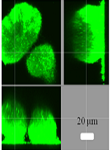|
|
|
Using anti-biofilm peptides to treat antibiotic-resistant bacterial infections
|
|
|
|
|
|
|
|
|
|

|
|
|
|
César de la Fuente-Núñez and Robert E.W. Hancock
|
|
|
|
University of British Columbia
|
|
Department of Microbiology and Immunology, Centre for Microbial Diseasesand Immunity Research, UBC, Vancouver, BC V6T 1Z4,Canada
|
|
bob@hancocklab.com
|
|
|
|
|
|
|
|
|
|

|
|
Host defense (antimicrobial) peptides (HDPs) are produced by virtually all organisms and have an important role in protection against microbial infections. Some naturally occurring peptides such as the human cathelicidin LL-37 and the bovine peptide indolicidin have been shown to inhibit bacterial biofilm development. Rearrangement and substantial modification of the amino acid sequence of these and other HDPs has led to the identification of small synthetic peptides with increased, broad-spectrum anti-biofilm activity that is independent of activity vs. planktonic cells. Some of these peptides have also been shown to act in synergy with antibiotics commonly used in the clinic to prevent biofilm formation and eradicate pre-existing biofilms. Recently, the mechanism of action of one of these peptides (i.e., 1018) was shown to involve binding to and causing degradation of the second messenger stress response nucleotide ppGpp, which plays an important role in biofilm formation and maintenance. Here, we review recent progress in the field of anti-biofilm peptides and propose future directions to further develop these therapeutic agents.
|
|
|
|
|
|
|
|

|
|